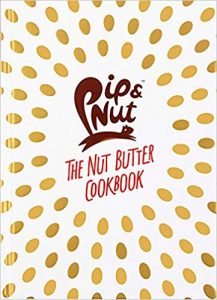In our Brand Story Hero series, we shine a regular spotlight on different brands that we think tell their story well. Here we take a look at Pip and Nut, the natural food company.

Brand: Pip and Nut.
Industry: Food.
Product: Nut butters and almond milks.
Founder: Pippa Murray
Year founded: 2015
Mission: “Call us crazy but we‘re obsessed by nuts and want to put them back on the nutritional map.”
Their story
In the early 2010’s Pippa Murray was training for a marathon. As a keen runner and health nut, she was always on the search for healthy snacks to eat before embarking on her outdoor adventures.

This search saw her try snacks and products that she didn’t really think were up to scratch. She believed food should be tasty, yet packed with nutrients and energy. This proved to be a difficult find, so much so she began making her own nut butters.

In an interview with the Daily Mail in 2017, she recalled her inspiration behind Pip and Nut; “Peanut butter is my favourite post-run treat as it is full of healthy fats and protein, which makes it great for recovery. However, I noticed that most of the brands available on the shelves were packed full of unnecessary ingredients such as palm oil and refined sugars, something which didn’t sit very well with me.”
Pippa kept the nut as the star of the show, moving all unnecessary ingredients, making sure her products were all natural.
It wasn’t long before her products caught the attention of other foodies. Pip & Nut was first sold at Maltby St Market in London. Quickly, Pippa found that her small production couldn’t fulfil demand.
To help her business grow Pippa started a crowdfunding campaign on Crowdcube to raise £100,000 in order to launch the business; she reached her target in just nine days and added another £20,000 to her fund in September 2014.
In January 2015, she launched her first nut butter onto the shelves of Selfridges. Today, you can find Pip & Nut products in more than 5,000 stories across the UK and Europe, including Sainsbury’s and Fortnum & Mason. It is the fastest growing nut butter brand in the UK.
Pippa has won a string of entrepreneurship awards for her work with Pip and Nut.
 Their storytelling lessons
Their storytelling lessons
Lesson #1 You’re allowed to be fun
Pip and Nut’s website is not your average company site. It is bright, engaging, fun and full of colour.
The site is full of quirky graphics and images and also hosts some interactive activities for visitors including answering the important question of “crunchy vs. smooth?”.
Pip and Nut’s website shows that when you’re launching a business or building a brand you don’t have to be boring. You can be fun, quirky and include as much personality as you want.
The website shows the brand’s personality perfectly. They are a fun loving team committed to creating healthy products for as many people to enjoy as possible.
 Lesson #2 Include your audience as much as possible
Lesson #2 Include your audience as much as possible
Pip and Nut keep their audience at the heart of their brand. They know how important they are to their growth and success.
To keep their audience at the heart, the team endeavour to include them as much as possible. This is achieved through a number of different initiatives.
Their audiences are affectionately referred to as “nutters’ or “squirrels” in line with their product. Creating a name for your audience allows them to become part of a community and gives them a sense of belonging and loyalty.
Another way, and possibly one of the biggest ways the team engage with their customers is through their ‘Hall of Nutters’ campaign.
They encourage their customers to photograph their food and recipes that use Pip and Nut products and send them to the team. These photos are then used on the Pip and Nut social media and credited to the photographer.
Again, this builds a sense of belonging and loyalty to the brand, because the brand is loyal to them.
Lesson #3 Pictures speak louder than words
This common phrase is true for Pip and Nut, especially when it comes to showcasing their food.
🐿️Toast Tuesday🐿️ PB banana – the ultimate classic #naturalnuttiness pic.twitter.com/Au1D7dnld8
— Pip&Nut (@pipandnut) February 12, 2019
This is where Pip and Nut use their audience engagement. In the majority of Pip and Nut’s social postings, on Twitter and Facebook, they include an image. More often then not they are ones from their audience.
This is not something that is done by accident, it is an intentional way of marketing their product to their audience.
People love looking at images of food. If you visit a restaurant you will see these people, maybe you’re one of them, who enjoy taking photos of their food to upload online. Pip and Nut have jumped on this bandwagon and are using both their own images and those of their customers to show the world what their products can do.
The results are beautiful, enticing and often mouth-watering photos.
Their storytelling tools
1) Pip and Nut Cookbook
Apart from spreading it on toast or adding it to your morning porridge many of us might struggle with ideas for how to include nut butter in our daily meals.
Pip and Nut have noticed an opportunity to increase their market by bringing out their own cookbook, full of ideas for how to use nut butter in smoothies, bakes and breakfast specials. The book also details how to make your own DIY butter.
The cookbook allows Pip and Nut to go further with their products. It allows them to continue their story with the products and develop new stories with them. The book also shows that the team behind Pip and Nut want to give their customers the ability to go further, create and make their own products.
2) Continue your story on social
Pip and Nut know the power of a good social story and social presence.
Company social media accounts can often be boring, stagnant and sometimes forgotten about. Not Pip and Nut.
The team manage successful social media accounts on Facebook, Twitter and Instagram. The accounts showcase Pip and Nut products and engage with their audiences in fun and creative ways.
By using social media Pip and Nut are able to extend their storytelling techniques and engage with different members of their audience. They are able to gather and communicate with their audience on a daily basis, showcasing new products and ideas.

